Gun Crime and Gun Law for Youth in Canada: A Criminology Report
VerifiedAdded on 2022/09/01
|7
|2007
|20
Report
AI Summary
This report examines the issue of gun crime and gun laws concerning youth in Canada. It begins by highlighting the rise of gun-related violence, particularly in major cities, and the impact on young offenders. The report references statistical data to illustrate the trends in gun violence, the role of handguns, and the shift in crime patterns. It explores the legal framework, including the Youth Criminal Justice Act and its impact on the treatment of young offenders, and the role of media in shaping public perception. The report also analyzes the government's approach to gun control, including the classification of firearms, and the factors contributing to the availability of illegal firearms. The study recommends the need for a more flexible approach in handling youth criminal cases, considering their age, maturity, and family background. It draws on academic articles and reports to provide a comprehensive overview of the subject and its implications for criminology, offering insights into the complexities of youth crime and the need for effective interventions.
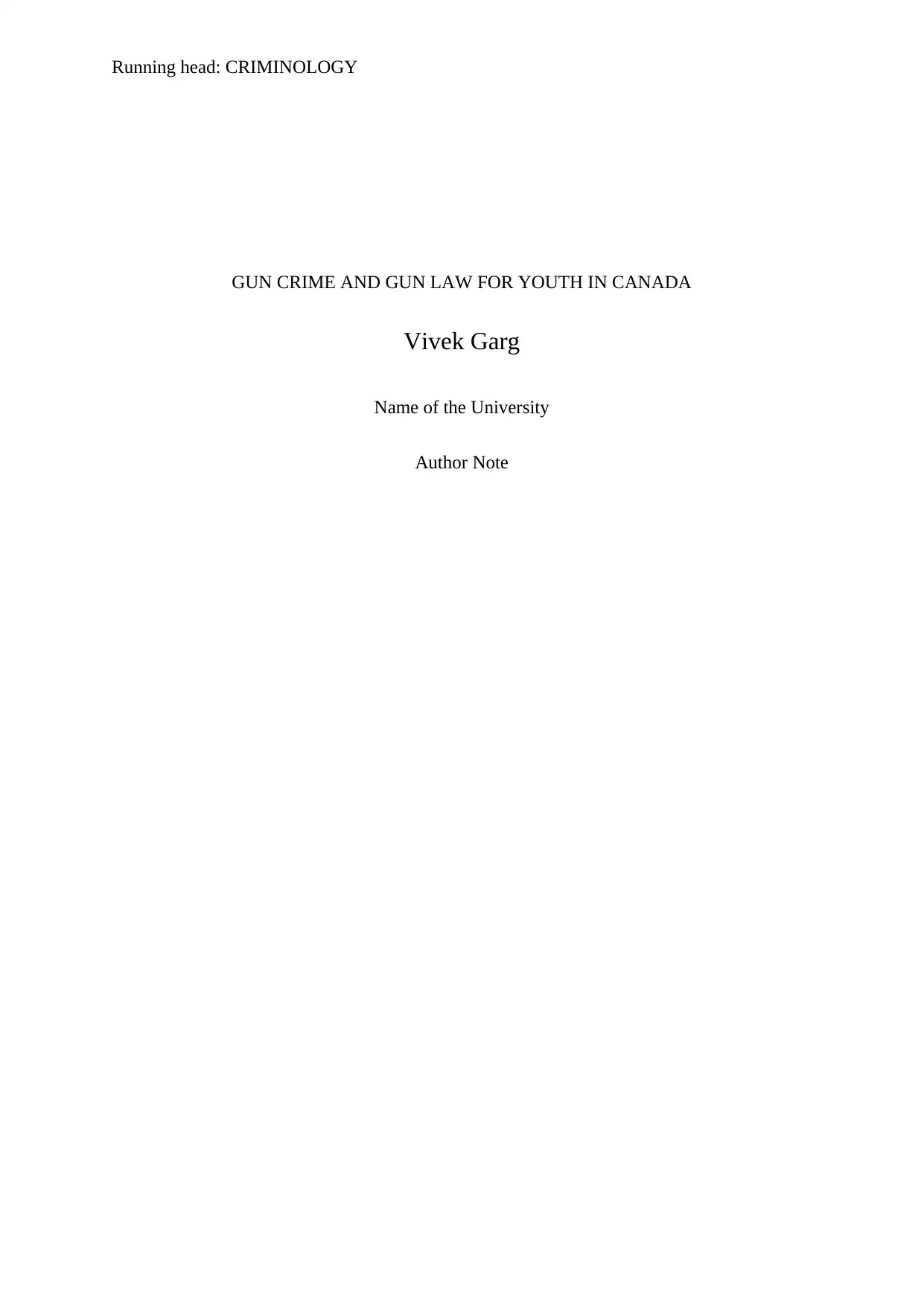
Running head: CRIMINOLOGY
GUN CRIME AND GUN LAW FOR YOUTH IN CANADA
Vivek Garg
Name of the University
Author Note
GUN CRIME AND GUN LAW FOR YOUTH IN CANADA
Vivek Garg
Name of the University
Author Note
Paraphrase This Document
Need a fresh take? Get an instant paraphrase of this document with our AI Paraphraser
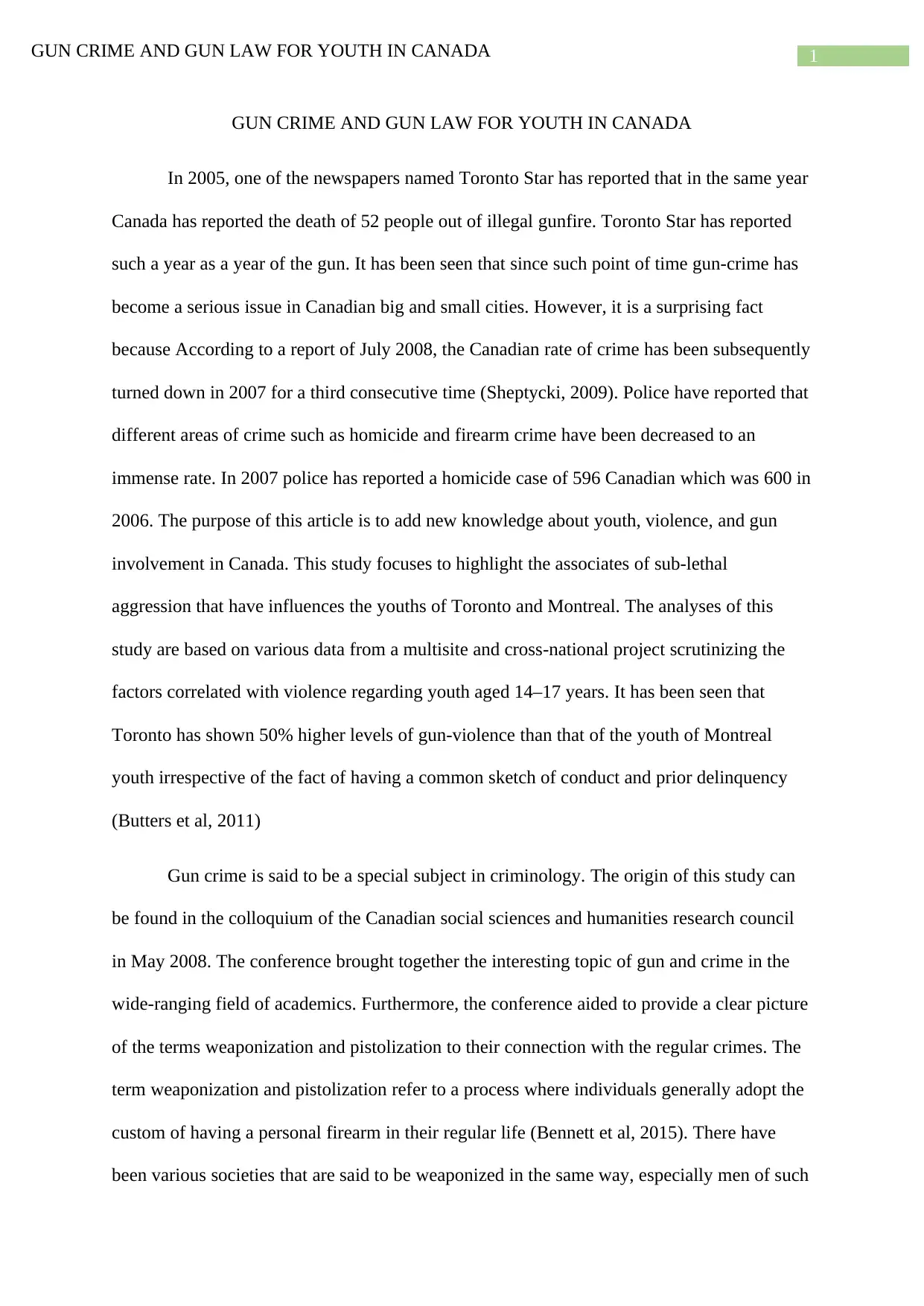
1GUN CRIME AND GUN LAW FOR YOUTH IN CANADA
GUN CRIME AND GUN LAW FOR YOUTH IN CANADA
In 2005, one of the newspapers named Toronto Star has reported that in the same year
Canada has reported the death of 52 people out of illegal gunfire. Toronto Star has reported
such a year as a year of the gun. It has been seen that since such point of time gun-crime has
become a serious issue in Canadian big and small cities. However, it is a surprising fact
because According to a report of July 2008, the Canadian rate of crime has been subsequently
turned down in 2007 for a third consecutive time (Sheptycki, 2009). Police have reported that
different areas of crime such as homicide and firearm crime have been decreased to an
immense rate. In 2007 police has reported a homicide case of 596 Canadian which was 600 in
2006. The purpose of this article is to add new knowledge about youth, violence, and gun
involvement in Canada. This study focuses to highlight the associates of sub-lethal
aggression that have influences the youths of Toronto and Montreal. The analyses of this
study are based on various data from a multisite and cross-national project scrutinizing the
factors correlated with violence regarding youth aged 14–17 years. It has been seen that
Toronto has shown 50% higher levels of gun-violence than that of the youth of Montreal
youth irrespective of the fact of having a common sketch of conduct and prior delinquency
(Butters et al, 2011)
Gun crime is said to be a special subject in criminology. The origin of this study can
be found in the colloquium of the Canadian social sciences and humanities research council
in May 2008. The conference brought together the interesting topic of gun and crime in the
wide-ranging field of academics. Furthermore, the conference aided to provide a clear picture
of the terms weaponization and pistolization to their connection with the regular crimes. The
term weaponization and pistolization refer to a process where individuals generally adopt the
custom of having a personal firearm in their regular life (Bennett et al, 2015). There have
been various societies that are said to be weaponized in the same way, especially men of such
GUN CRIME AND GUN LAW FOR YOUTH IN CANADA
In 2005, one of the newspapers named Toronto Star has reported that in the same year
Canada has reported the death of 52 people out of illegal gunfire. Toronto Star has reported
such a year as a year of the gun. It has been seen that since such point of time gun-crime has
become a serious issue in Canadian big and small cities. However, it is a surprising fact
because According to a report of July 2008, the Canadian rate of crime has been subsequently
turned down in 2007 for a third consecutive time (Sheptycki, 2009). Police have reported that
different areas of crime such as homicide and firearm crime have been decreased to an
immense rate. In 2007 police has reported a homicide case of 596 Canadian which was 600 in
2006. The purpose of this article is to add new knowledge about youth, violence, and gun
involvement in Canada. This study focuses to highlight the associates of sub-lethal
aggression that have influences the youths of Toronto and Montreal. The analyses of this
study are based on various data from a multisite and cross-national project scrutinizing the
factors correlated with violence regarding youth aged 14–17 years. It has been seen that
Toronto has shown 50% higher levels of gun-violence than that of the youth of Montreal
youth irrespective of the fact of having a common sketch of conduct and prior delinquency
(Butters et al, 2011)
Gun crime is said to be a special subject in criminology. The origin of this study can
be found in the colloquium of the Canadian social sciences and humanities research council
in May 2008. The conference brought together the interesting topic of gun and crime in the
wide-ranging field of academics. Furthermore, the conference aided to provide a clear picture
of the terms weaponization and pistolization to their connection with the regular crimes. The
term weaponization and pistolization refer to a process where individuals generally adopt the
custom of having a personal firearm in their regular life (Bennett et al, 2015). There have
been various societies that are said to be weaponized in the same way, especially men of such
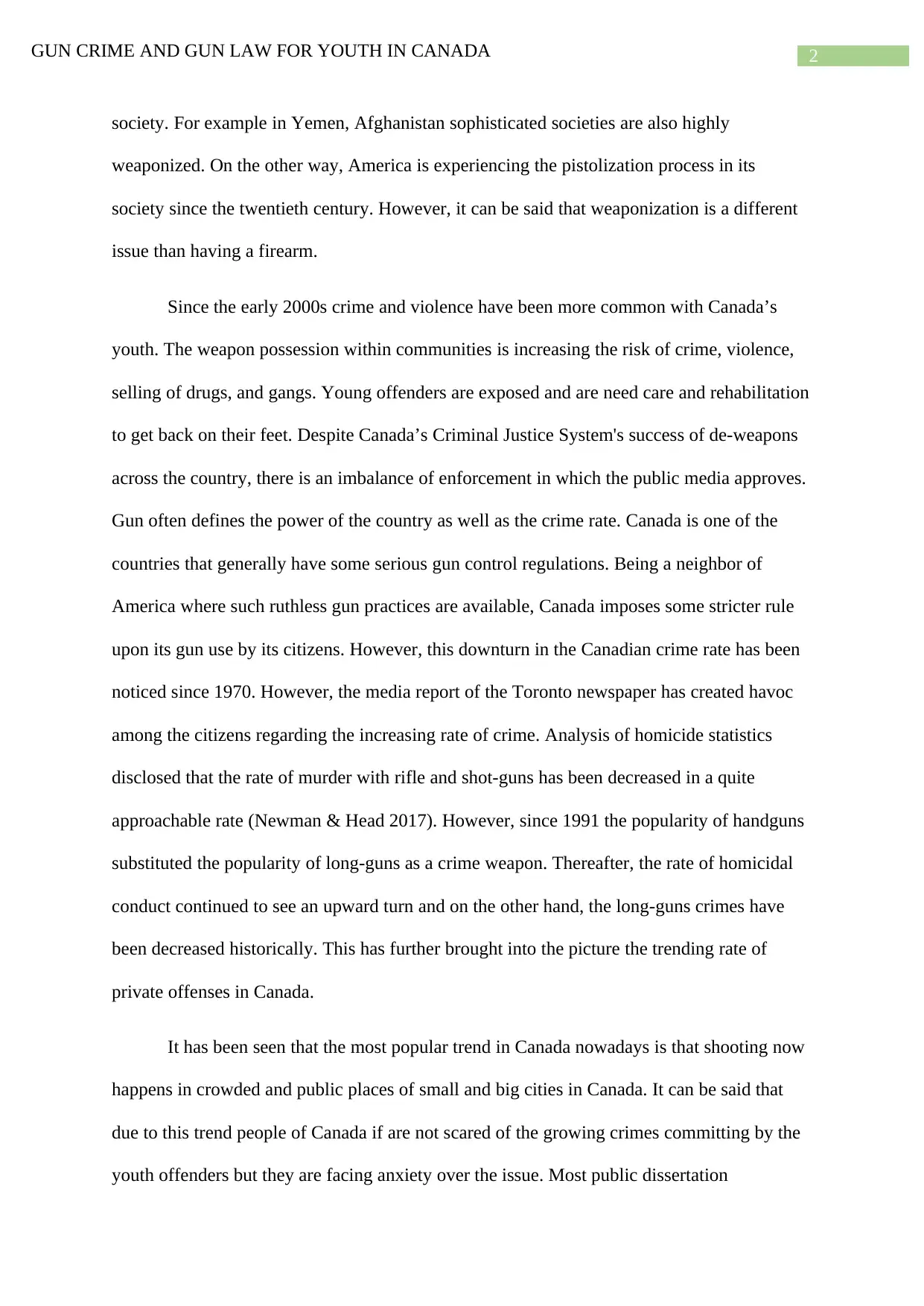
2GUN CRIME AND GUN LAW FOR YOUTH IN CANADA
society. For example in Yemen, Afghanistan sophisticated societies are also highly
weaponized. On the other way, America is experiencing the pistolization process in its
society since the twentieth century. However, it can be said that weaponization is a different
issue than having a firearm.
Since the early 2000s crime and violence have been more common with Canada’s
youth. The weapon possession within communities is increasing the risk of crime, violence,
selling of drugs, and gangs. Young offenders are exposed and are need care and rehabilitation
to get back on their feet. Despite Canada’s Criminal Justice System's success of de-weapons
across the country, there is an imbalance of enforcement in which the public media approves.
Gun often defines the power of the country as well as the crime rate. Canada is one of the
countries that generally have some serious gun control regulations. Being a neighbor of
America where such ruthless gun practices are available, Canada imposes some stricter rule
upon its gun use by its citizens. However, this downturn in the Canadian crime rate has been
noticed since 1970. However, the media report of the Toronto newspaper has created havoc
among the citizens regarding the increasing rate of crime. Analysis of homicide statistics
disclosed that the rate of murder with rifle and shot-guns has been decreased in a quite
approachable rate (Newman & Head 2017). However, since 1991 the popularity of handguns
substituted the popularity of long-guns as a crime weapon. Thereafter, the rate of homicidal
conduct continued to see an upward turn and on the other hand, the long-guns crimes have
been decreased historically. This has further brought into the picture the trending rate of
private offenses in Canada.
It has been seen that the most popular trend in Canada nowadays is that shooting now
happens in crowded and public places of small and big cities in Canada. It can be said that
due to this trend people of Canada if are not scared of the growing crimes committing by the
youth offenders but they are facing anxiety over the issue. Most public dissertation
society. For example in Yemen, Afghanistan sophisticated societies are also highly
weaponized. On the other way, America is experiencing the pistolization process in its
society since the twentieth century. However, it can be said that weaponization is a different
issue than having a firearm.
Since the early 2000s crime and violence have been more common with Canada’s
youth. The weapon possession within communities is increasing the risk of crime, violence,
selling of drugs, and gangs. Young offenders are exposed and are need care and rehabilitation
to get back on their feet. Despite Canada’s Criminal Justice System's success of de-weapons
across the country, there is an imbalance of enforcement in which the public media approves.
Gun often defines the power of the country as well as the crime rate. Canada is one of the
countries that generally have some serious gun control regulations. Being a neighbor of
America where such ruthless gun practices are available, Canada imposes some stricter rule
upon its gun use by its citizens. However, this downturn in the Canadian crime rate has been
noticed since 1970. However, the media report of the Toronto newspaper has created havoc
among the citizens regarding the increasing rate of crime. Analysis of homicide statistics
disclosed that the rate of murder with rifle and shot-guns has been decreased in a quite
approachable rate (Newman & Head 2017). However, since 1991 the popularity of handguns
substituted the popularity of long-guns as a crime weapon. Thereafter, the rate of homicidal
conduct continued to see an upward turn and on the other hand, the long-guns crimes have
been decreased historically. This has further brought into the picture the trending rate of
private offenses in Canada.
It has been seen that the most popular trend in Canada nowadays is that shooting now
happens in crowded and public places of small and big cities in Canada. It can be said that
due to this trend people of Canada if are not scared of the growing crimes committing by the
youth offenders but they are facing anxiety over the issue. Most public dissertation
⊘ This is a preview!⊘
Do you want full access?
Subscribe today to unlock all pages.

Trusted by 1+ million students worldwide
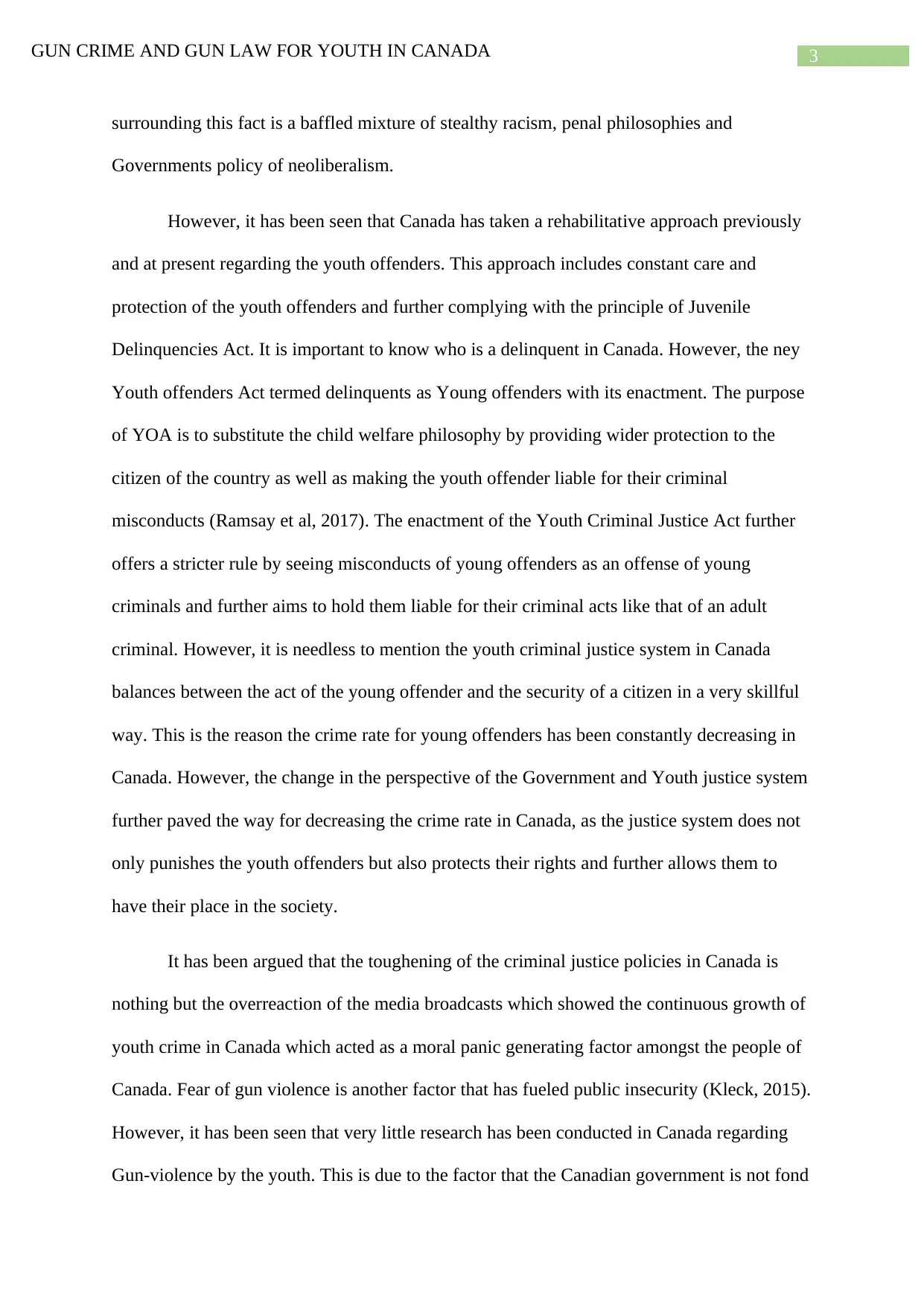
3GUN CRIME AND GUN LAW FOR YOUTH IN CANADA
surrounding this fact is a baffled mixture of stealthy racism, penal philosophies and
Governments policy of neoliberalism.
However, it has been seen that Canada has taken a rehabilitative approach previously
and at present regarding the youth offenders. This approach includes constant care and
protection of the youth offenders and further complying with the principle of Juvenile
Delinquencies Act. It is important to know who is a delinquent in Canada. However, the ney
Youth offenders Act termed delinquents as Young offenders with its enactment. The purpose
of YOA is to substitute the child welfare philosophy by providing wider protection to the
citizen of the country as well as making the youth offender liable for their criminal
misconducts (Ramsay et al, 2017). The enactment of the Youth Criminal Justice Act further
offers a stricter rule by seeing misconducts of young offenders as an offense of young
criminals and further aims to hold them liable for their criminal acts like that of an adult
criminal. However, it is needless to mention the youth criminal justice system in Canada
balances between the act of the young offender and the security of a citizen in a very skillful
way. This is the reason the crime rate for young offenders has been constantly decreasing in
Canada. However, the change in the perspective of the Government and Youth justice system
further paved the way for decreasing the crime rate in Canada, as the justice system does not
only punishes the youth offenders but also protects their rights and further allows them to
have their place in the society.
It has been argued that the toughening of the criminal justice policies in Canada is
nothing but the overreaction of the media broadcasts which showed the continuous growth of
youth crime in Canada which acted as a moral panic generating factor amongst the people of
Canada. Fear of gun violence is another factor that has fueled public insecurity (Kleck, 2015).
However, it has been seen that very little research has been conducted in Canada regarding
Gun-violence by the youth. This is due to the factor that the Canadian government is not fond
surrounding this fact is a baffled mixture of stealthy racism, penal philosophies and
Governments policy of neoliberalism.
However, it has been seen that Canada has taken a rehabilitative approach previously
and at present regarding the youth offenders. This approach includes constant care and
protection of the youth offenders and further complying with the principle of Juvenile
Delinquencies Act. It is important to know who is a delinquent in Canada. However, the ney
Youth offenders Act termed delinquents as Young offenders with its enactment. The purpose
of YOA is to substitute the child welfare philosophy by providing wider protection to the
citizen of the country as well as making the youth offender liable for their criminal
misconducts (Ramsay et al, 2017). The enactment of the Youth Criminal Justice Act further
offers a stricter rule by seeing misconducts of young offenders as an offense of young
criminals and further aims to hold them liable for their criminal acts like that of an adult
criminal. However, it is needless to mention the youth criminal justice system in Canada
balances between the act of the young offender and the security of a citizen in a very skillful
way. This is the reason the crime rate for young offenders has been constantly decreasing in
Canada. However, the change in the perspective of the Government and Youth justice system
further paved the way for decreasing the crime rate in Canada, as the justice system does not
only punishes the youth offenders but also protects their rights and further allows them to
have their place in the society.
It has been argued that the toughening of the criminal justice policies in Canada is
nothing but the overreaction of the media broadcasts which showed the continuous growth of
youth crime in Canada which acted as a moral panic generating factor amongst the people of
Canada. Fear of gun violence is another factor that has fueled public insecurity (Kleck, 2015).
However, it has been seen that very little research has been conducted in Canada regarding
Gun-violence by the youth. This is due to the factor that the Canadian government is not fond
Paraphrase This Document
Need a fresh take? Get an instant paraphrase of this document with our AI Paraphraser
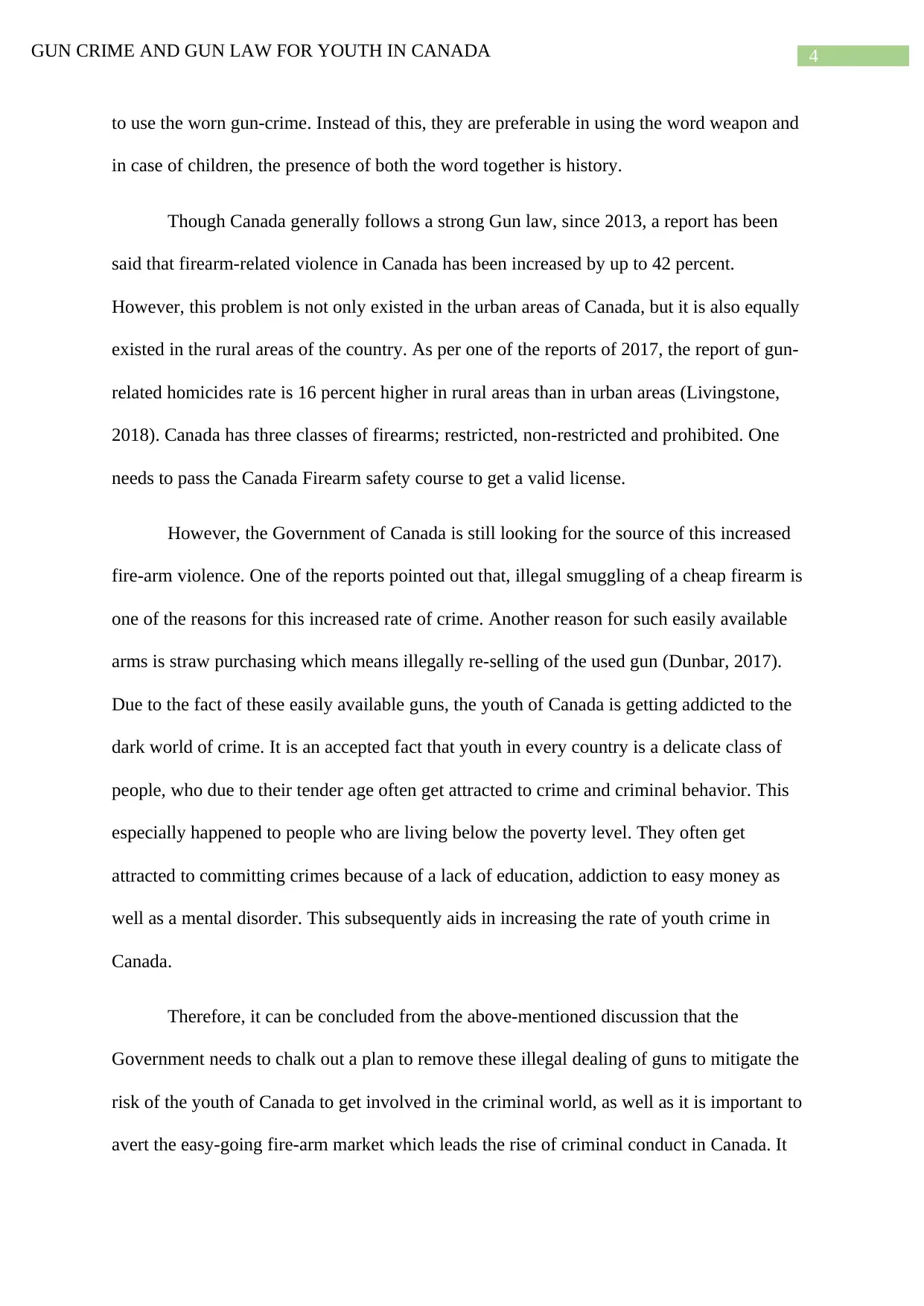
4GUN CRIME AND GUN LAW FOR YOUTH IN CANADA
to use the worn gun-crime. Instead of this, they are preferable in using the word weapon and
in case of children, the presence of both the word together is history.
Though Canada generally follows a strong Gun law, since 2013, a report has been
said that firearm-related violence in Canada has been increased by up to 42 percent.
However, this problem is not only existed in the urban areas of Canada, but it is also equally
existed in the rural areas of the country. As per one of the reports of 2017, the report of gun-
related homicides rate is 16 percent higher in rural areas than in urban areas (Livingstone,
2018). Canada has three classes of firearms; restricted, non-restricted and prohibited. One
needs to pass the Canada Firearm safety course to get a valid license.
However, the Government of Canada is still looking for the source of this increased
fire-arm violence. One of the reports pointed out that, illegal smuggling of a cheap firearm is
one of the reasons for this increased rate of crime. Another reason for such easily available
arms is straw purchasing which means illegally re-selling of the used gun (Dunbar, 2017).
Due to the fact of these easily available guns, the youth of Canada is getting addicted to the
dark world of crime. It is an accepted fact that youth in every country is a delicate class of
people, who due to their tender age often get attracted to crime and criminal behavior. This
especially happened to people who are living below the poverty level. They often get
attracted to committing crimes because of a lack of education, addiction to easy money as
well as a mental disorder. This subsequently aids in increasing the rate of youth crime in
Canada.
Therefore, it can be concluded from the above-mentioned discussion that the
Government needs to chalk out a plan to remove these illegal dealing of guns to mitigate the
risk of the youth of Canada to get involved in the criminal world, as well as it is important to
avert the easy-going fire-arm market which leads the rise of criminal conduct in Canada. It
to use the worn gun-crime. Instead of this, they are preferable in using the word weapon and
in case of children, the presence of both the word together is history.
Though Canada generally follows a strong Gun law, since 2013, a report has been
said that firearm-related violence in Canada has been increased by up to 42 percent.
However, this problem is not only existed in the urban areas of Canada, but it is also equally
existed in the rural areas of the country. As per one of the reports of 2017, the report of gun-
related homicides rate is 16 percent higher in rural areas than in urban areas (Livingstone,
2018). Canada has three classes of firearms; restricted, non-restricted and prohibited. One
needs to pass the Canada Firearm safety course to get a valid license.
However, the Government of Canada is still looking for the source of this increased
fire-arm violence. One of the reports pointed out that, illegal smuggling of a cheap firearm is
one of the reasons for this increased rate of crime. Another reason for such easily available
arms is straw purchasing which means illegally re-selling of the used gun (Dunbar, 2017).
Due to the fact of these easily available guns, the youth of Canada is getting addicted to the
dark world of crime. It is an accepted fact that youth in every country is a delicate class of
people, who due to their tender age often get attracted to crime and criminal behavior. This
especially happened to people who are living below the poverty level. They often get
attracted to committing crimes because of a lack of education, addiction to easy money as
well as a mental disorder. This subsequently aids in increasing the rate of youth crime in
Canada.
Therefore, it can be concluded from the above-mentioned discussion that the
Government needs to chalk out a plan to remove these illegal dealing of guns to mitigate the
risk of the youth of Canada to get involved in the criminal world, as well as it is important to
avert the easy-going fire-arm market which leads the rise of criminal conduct in Canada. It
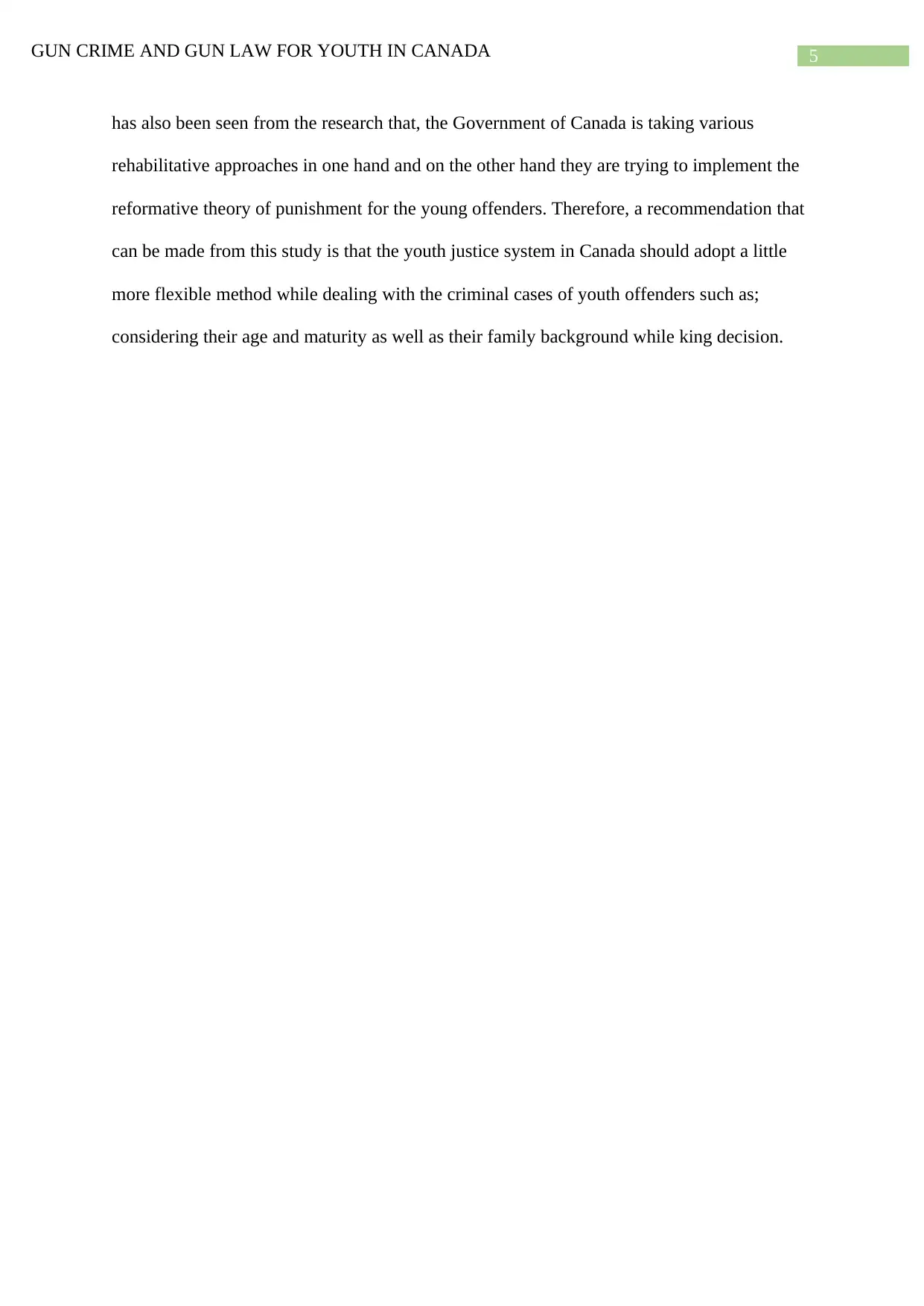
5GUN CRIME AND GUN LAW FOR YOUTH IN CANADA
has also been seen from the research that, the Government of Canada is taking various
rehabilitative approaches in one hand and on the other hand they are trying to implement the
reformative theory of punishment for the young offenders. Therefore, a recommendation that
can be made from this study is that the youth justice system in Canada should adopt a little
more flexible method while dealing with the criminal cases of youth offenders such as;
considering their age and maturity as well as their family background while king decision.
has also been seen from the research that, the Government of Canada is taking various
rehabilitative approaches in one hand and on the other hand they are trying to implement the
reformative theory of punishment for the young offenders. Therefore, a recommendation that
can be made from this study is that the youth justice system in Canada should adopt a little
more flexible method while dealing with the criminal cases of youth offenders such as;
considering their age and maturity as well as their family background while king decision.
⊘ This is a preview!⊘
Do you want full access?
Subscribe today to unlock all pages.

Trusted by 1+ million students worldwide
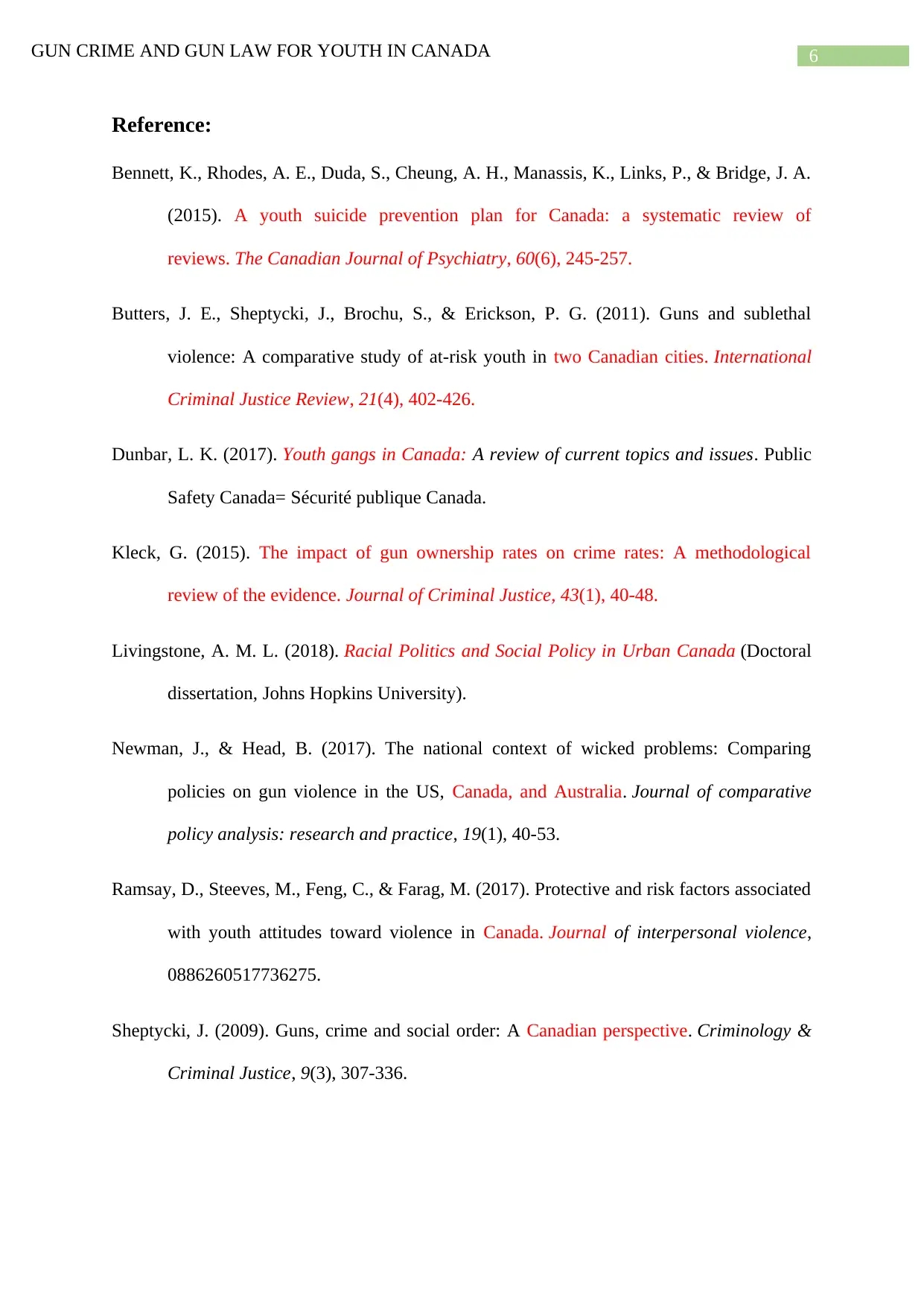
6GUN CRIME AND GUN LAW FOR YOUTH IN CANADA
Reference:
Bennett, K., Rhodes, A. E., Duda, S., Cheung, A. H., Manassis, K., Links, P., & Bridge, J. A.
(2015). A youth suicide prevention plan for Canada: a systematic review of
reviews. The Canadian Journal of Psychiatry, 60(6), 245-257.
Butters, J. E., Sheptycki, J., Brochu, S., & Erickson, P. G. (2011). Guns and sublethal
violence: A comparative study of at-risk youth in two Canadian cities. International
Criminal Justice Review, 21(4), 402-426.
Dunbar, L. K. (2017). Youth gangs in Canada: A review of current topics and issues. Public
Safety Canada= Sécurité publique Canada.
Kleck, G. (2015). The impact of gun ownership rates on crime rates: A methodological
review of the evidence. Journal of Criminal Justice, 43(1), 40-48.
Livingstone, A. M. L. (2018). Racial Politics and Social Policy in Urban Canada (Doctoral
dissertation, Johns Hopkins University).
Newman, J., & Head, B. (2017). The national context of wicked problems: Comparing
policies on gun violence in the US, Canada, and Australia. Journal of comparative
policy analysis: research and practice, 19(1), 40-53.
Ramsay, D., Steeves, M., Feng, C., & Farag, M. (2017). Protective and risk factors associated
with youth attitudes toward violence in Canada. Journal of interpersonal violence,
0886260517736275.
Sheptycki, J. (2009). Guns, crime and social order: A Canadian perspective. Criminology &
Criminal Justice, 9(3), 307-336.
Reference:
Bennett, K., Rhodes, A. E., Duda, S., Cheung, A. H., Manassis, K., Links, P., & Bridge, J. A.
(2015). A youth suicide prevention plan for Canada: a systematic review of
reviews. The Canadian Journal of Psychiatry, 60(6), 245-257.
Butters, J. E., Sheptycki, J., Brochu, S., & Erickson, P. G. (2011). Guns and sublethal
violence: A comparative study of at-risk youth in two Canadian cities. International
Criminal Justice Review, 21(4), 402-426.
Dunbar, L. K. (2017). Youth gangs in Canada: A review of current topics and issues. Public
Safety Canada= Sécurité publique Canada.
Kleck, G. (2015). The impact of gun ownership rates on crime rates: A methodological
review of the evidence. Journal of Criminal Justice, 43(1), 40-48.
Livingstone, A. M. L. (2018). Racial Politics and Social Policy in Urban Canada (Doctoral
dissertation, Johns Hopkins University).
Newman, J., & Head, B. (2017). The national context of wicked problems: Comparing
policies on gun violence in the US, Canada, and Australia. Journal of comparative
policy analysis: research and practice, 19(1), 40-53.
Ramsay, D., Steeves, M., Feng, C., & Farag, M. (2017). Protective and risk factors associated
with youth attitudes toward violence in Canada. Journal of interpersonal violence,
0886260517736275.
Sheptycki, J. (2009). Guns, crime and social order: A Canadian perspective. Criminology &
Criminal Justice, 9(3), 307-336.
1 out of 7
Related Documents
Your All-in-One AI-Powered Toolkit for Academic Success.
+13062052269
info@desklib.com
Available 24*7 on WhatsApp / Email
![[object Object]](/_next/static/media/star-bottom.7253800d.svg)
Unlock your academic potential
Copyright © 2020–2025 A2Z Services. All Rights Reserved. Developed and managed by ZUCOL.




